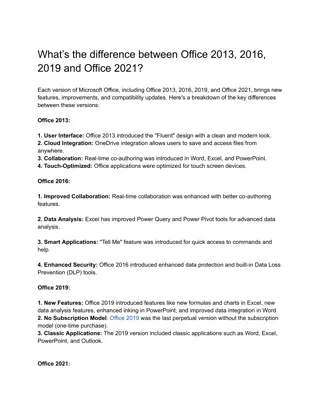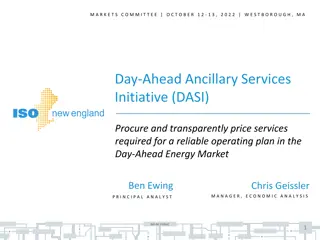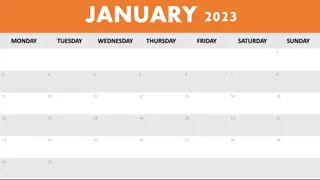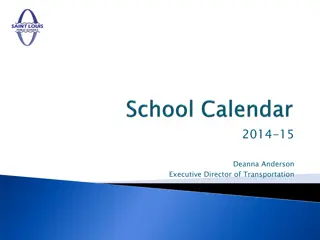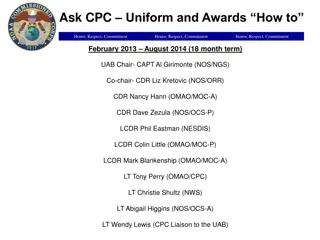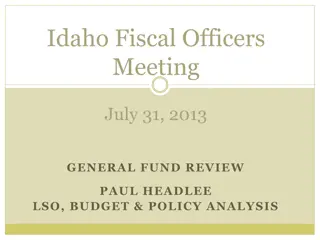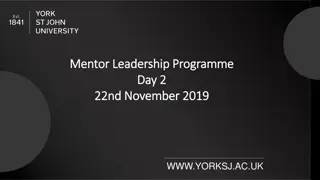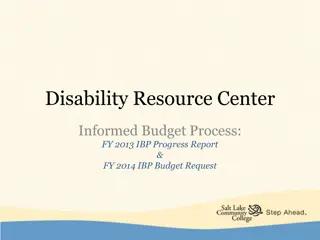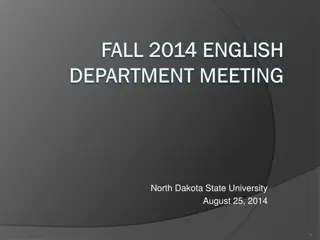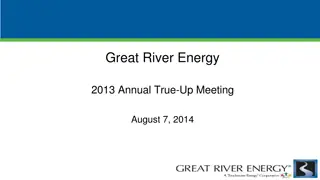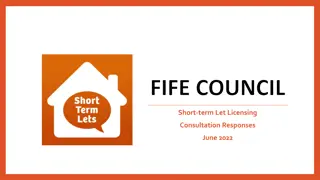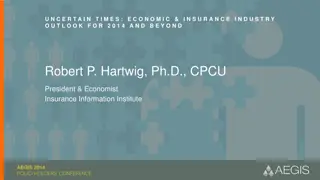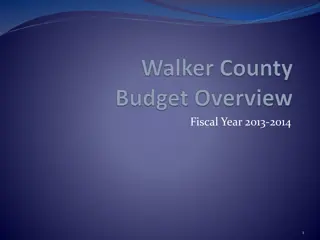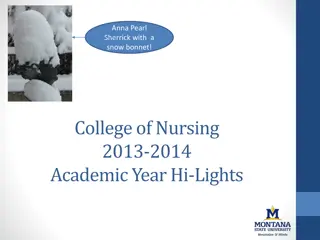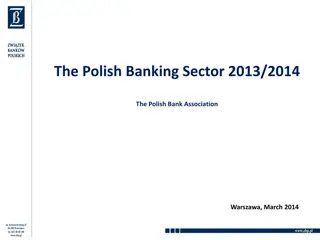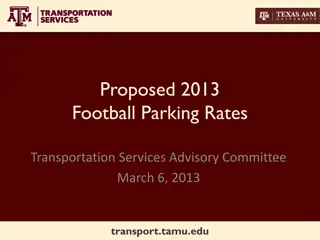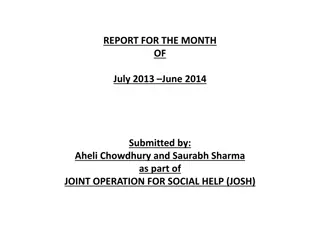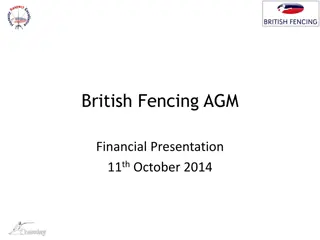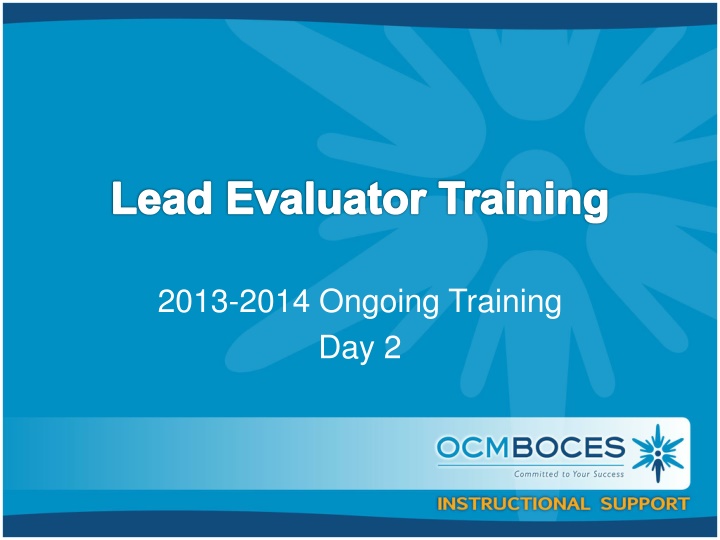
Lead Evaluator Training Agenda and Review
Explore ongoing lead evaluator training with a focus on New York State teaching standards, evidence-based observation, and the use of student growth data. Learn about the process for certifying lead evaluators and ensuring reliability in evaluations.
Download Presentation

Please find below an Image/Link to download the presentation.
The content on the website is provided AS IS for your information and personal use only. It may not be sold, licensed, or shared on other websites without obtaining consent from the author. If you encounter any issues during the download, it is possible that the publisher has removed the file from their server.
You are allowed to download the files provided on this website for personal or commercial use, subject to the condition that they are used lawfully. All files are the property of their respective owners.
The content on the website is provided AS IS for your information and personal use only. It may not be sold, licensed, or shared on other websites without obtaining consent from the author.
E N D
Presentation Transcript
Lead Evaluator Training 2013-2014 Ongoing Training Day 2
Welcome Back! [re]Orientation Lead Evaluator Training Agenda Review
Lead Evaluator Training New York State Teaching Standards and Leadership Standards Evidence-based observation Application and use of Student Growth Percentile and VA Growth Model data Application and use of the State-approved teacher or principal rubrics Application and use of any assessment tools used to evaluate teachers and principals Application and use of State-approved locally selected measures of student achievement Use of the Statewide Instructional Reporting System Scoring methodology used to evaluate teachers and principals Specific considerations in evaluating teachers and principals of ELLs and students with disabilities
Lead Evaluator Training From the Review Room: Describe the process by which evaluators will be trained and the process for how the district will certify and re-certify lead evaluators. Describe the process for ensuring inter- rater reliability. Describe the duration and nature of such training.
Lead Evaluator Training Continue to collect evidence Use collected evidence to rate teachers on a rubric (with feedback) Manage the new system Employ growth-producing feedback to increase the quality of teaching Implement the Reform Agenda (RTTT)
Lead Evaluator Training Or, to basically increase the likelihood that all of this can make a difference.
Agenda Middle of the Year Artifact Review Evidence Collection Scoring (with feedback) Growth Producing Feedback
Enhancing the Impact of Feedback to Teachers
Background Authors interviewed teachers, some successful and some struggling, and identified common concerns: Infrequent visits are unnerving Uncertain expectations create anxiety Waiting is difficult Sense of Disempowerment Lack of Helpful Information
Directions Read each of the concerns. As a table, suggest some strategies you could employ to diffuse the concern.
Author Suggestions Use effective interpersonal strategies Sequence the conversation into a predictable format Address the teacher s concerns; listen Co-develop next steps
The Year at a Glance Ongoing End of the Year Beginning of the Year Beginning of the year meeting Standards I and II SLO and local (LAT) target setting Evidence Submission by Teacher Evidence Collection Sharing the evidence Feedback Conversations Evidence from the year collected Compare collected evidence to the rubric Summative score determination and communication
The Year at a Glance Ongoing End of the Year Beginning of the Year Beginning of the year meeting Standards I and II SLO and local (LAT) target setting Evidence Submission by Teacher Evidence Collection Sharing the evidence Feedback Conversations Evidence from the year collected Compare collected evidence to the rubric Summative score determination and communication
The Year at a Glance Ongoing End of the Year Beginning of the Year Beginning of the year meeting Standards I and II SLO and local (LAT) target setting Evidence Submission by Teacher Evidence Collection Sharing the evidence Feedback Conversations Evidence from the year collected Compare collected evidence to the rubric Summative score determination and communication
Artifacts What have you done in your building to help teachers with the submission of artifacts? Talk at your table.
Assessment as Evidence NYS Teaching Standard 5
Assessment Common Formative Assessments Common Interim Assessments Student Learning Objectives External Assessments Balanced Assessment System Classroom Assessments Worksheets, classroom response, whiteboards, exit tickets, conferences, student self- assessment Performances, tests, or writing prompts given every 6-8 weeks Growth measures designed for use with the APPR growth and local achievement Common tasks and prompts assessed with rubric, quizzes Chapter/unit tests, final projects 3-8 tests, Regents exams, SAT, AP Examples Very formative; can be diagnostic if used prior to instruction Formative and summative Format Mostly summative Formative Summative Very summative Grade level/discipline teams of teachers working together. District teams of representative teachers may also look at the data Teachers and lead evaluators/principals An external group of experts Responsibility Classroom teachers Classroom teachers Provides immediate feedback and guides instructional decisions To assess student learning in order to make instructional decisions. Also serves to assess curriculum, instruction, and pacing. Conversion to scores for use in teacher and principal evaluation Accountability and placement Purpose Provision of grades
Assessment Tables work as groups of four for this activity. 1. Each person (of four) picks one of the articles 2. Read your own article (do 3-2-1) 3. Like people meet to discuss and agree on the most important things in the article 4. Go back to original group and share
Assessment How could you use an activity like this in your school?
The Year at a Glance Ongoing End of the Year Beginning of the Year Beginning of the year meeting Standards I and II SLO and local (LAT) target setting Evidence Submission by Teacher Evidence Collection Sharing the evidence Feedback Conversations Evidence from the year collected Compare collected evidence to the rubric Summative score determination and communication
Artifacts Examine some more artifacts. In your folder you will find: Assessment examples Lesson plan example Friday Folder example (and annotation)
Back to Assessment Now that you looked at some assessment, talk about assessments, in general, and what they tell you at your table. What else would you want to see? What questions do you have for the teacher?
Back to Assessment Think about your assessment conversations. Ask yourself: Are they about common formative assessment? About making instructional decisions based on formative assessment? Or are they about the administration, scoring, and results of state tests and exams?
The Year at a Glance Ongoing End of the Year Beginning of the Year Beginning of the year meeting Standards I and II SLO and local (LAT) target setting Evidence Submission by Teacher Evidence Collection Sharing the evidence Feedback Conversations Evidence from the year collected Compare collected evidence to the rubric Summative score determination and communication
Evidence Collection Collect evidence Clean it up Code it Sort it Score it (use answer sheet to record your answers) Leave your totaled sheet behind
Evidence Collection How did you do? At your table? So what? Leave your totaled sheet behind
Growth Producing Feedback
Growth Producing Feedback Page 1: Talk about what resonates more (or less) for you. Page 2: Look at the continuum. At your table, talk about each C one by one. After each, individually, jot down your recollection of an recent experience in which you acted that way. Page 3: Individually, list your staff members names in the column that reflects how you most typically interact with each. Page 4: As a group, look the page over, again talking about what resonates more (or less) for you.
Growth Producing Feedback At your table, talk about the feedback you would give our teacher after her lesson. Talk about which C is the approach you would take with her.
Closure: On My Mind 1. On a 5x8 card, write a question about instructional leadership or supervision/evaluation. Write one question per card.
Closure: On My Mind 2. Circulate the cards around your table. When you encounter a question about which you are curious add a dot to it.
Closure: On My Mind 3. After three minutes, exchange your table s cards with another table; repeat
Closure: On My Mind 4. Report out the card with the most dots to the larger group
On Your Own Read the Conference that Make a Difference article. It sums things up very well.
A Good Resource Many of the ideas and resources from today s session come from Paula Rutherford and Just ASK Publications. If no one in your district has one of these please come and take one.
Next Session March 17th in Syracuse March 18th in Cortland Agenda will include Evidence for Standards 6 & 7 (Domain 4) Summative Evaluations Growth-Producing Feedback, including difficult conversations


